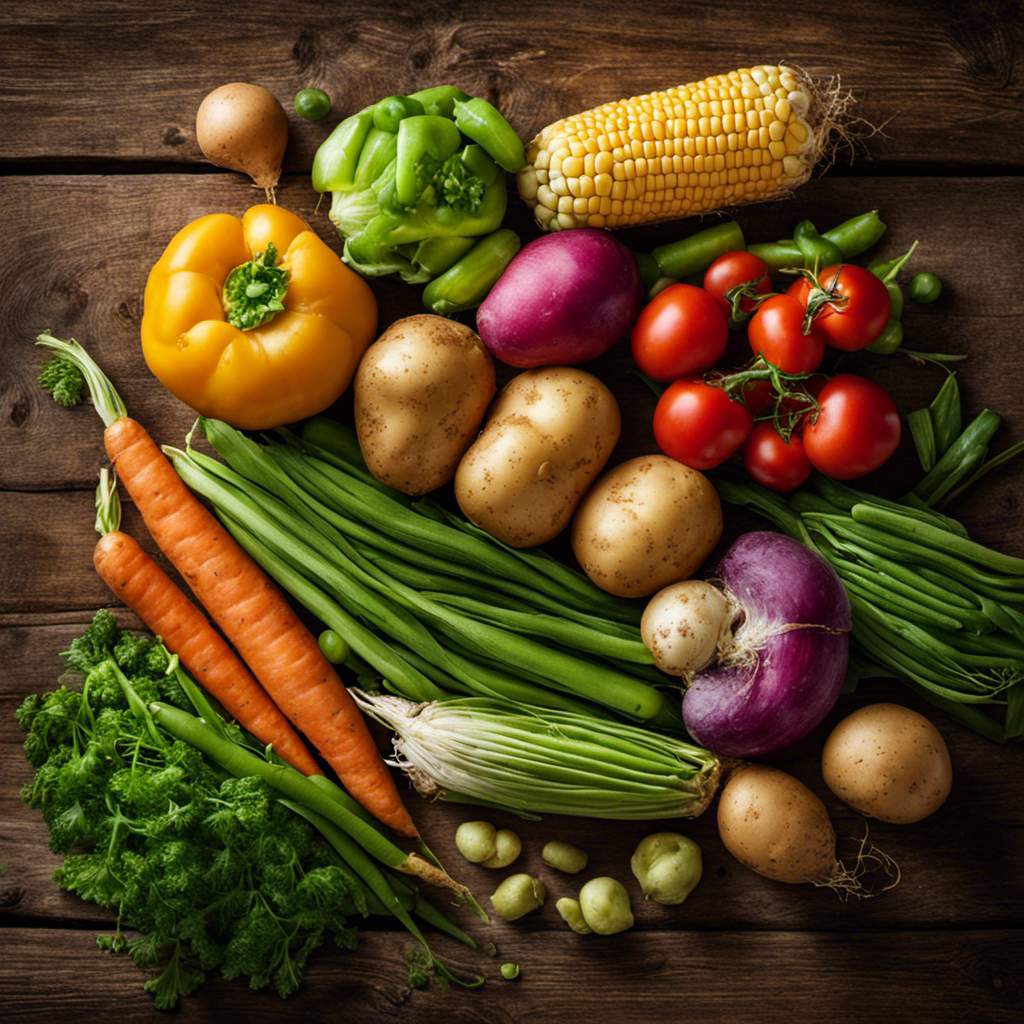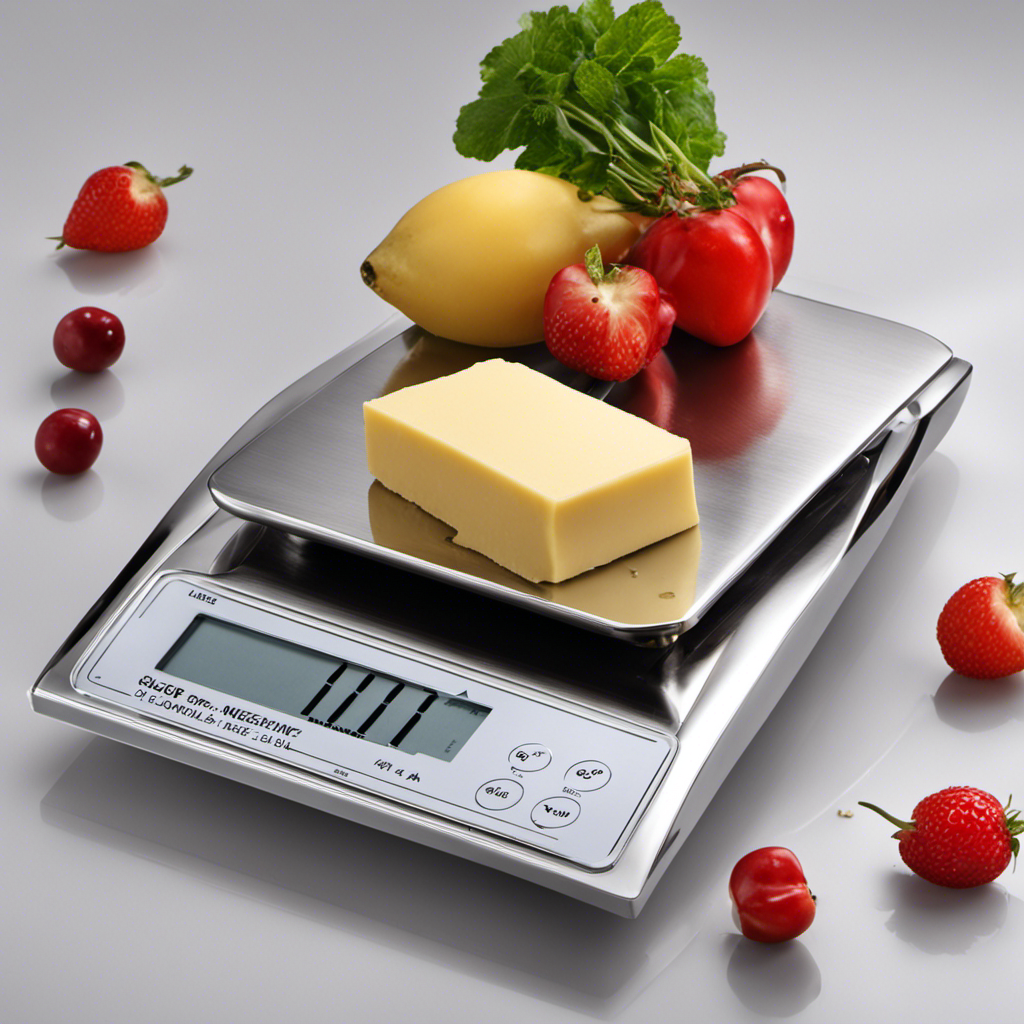Are you aware that carbohydrates are a vital source of energy for our bodies?
In this article, I will explore the question of which among butter, beef, fish, and vegetables is the most abundant source of carbohydrates.
By examining their carbohydrate content, we can make informed choices about our diet.
So, let’s dive in and uncover the facts to help you make healthier and more nutritious choices.
Key Takeaways
- Butter has the lowest carbohydrate content among the options, with less than 0.1 grams per tablespoon.
- Beef and fish also have minimal amounts of carbohydrates, with about 0 grams per 100 grams.
- Vegetables can vary widely in their carbohydrate content, with leafy greens having very low amounts and starchy vegetables like potatoes and corn containing higher amounts.
- Cooking methods can affect the carbohydrate content and glycemic index of vegetables, with boiling causing some carbohydrates to leach out and steaming having a lower glycemic index compared to boiling or frying.
The Role of Butter in Carbohydrate Intake
Butter isn’t a significant source of carbohydrates in my diet. When exploring the impact of butter on blood sugar levels, it’s important to note that butter contains a negligible amount of carbohydrates. According to the USDA National Nutrient Database, butter contains less than 0.1 grams of carbohydrates per tablespoon. This means that butter has a minimal effect on blood sugar levels, making it suitable for those following a low carb diet.
While it’s important to limit carbohydrate intake for blood sugar control, it’s also crucial to consider the overall balance of nutrients in a diet. Butter can be incorporated into a low carb diet in moderation, providing flavor and satiety without significantly affecting carbohydrate intake.
Exploring the Carbohydrate Content in Beef
I can explore the carbohydrate content in beef to determine its nutritional value. When it comes to beef nutrition, carbohydrates aren’t the main focus. Beef is primarily known for its protein and fat content. However, it does contain a small amount of carbohydrates.
On average, beef contains about 0 grams of carbohydrates per 100 grams. This makes it a low-carb food option. While carbohydrates are an important macronutrient for our bodies, they aren’t the main component we look for in beef.
Protein is the star of the show, providing essential amino acids that our bodies need for muscle growth and repair. So, while beef may not be a significant source of carbohydrates, it still provides valuable nutrition in the form of protein and fats.
Unveiling the Carbohydrate Composition of Fish
Salmon, for example, contains a negligible amount of carbohydrates while being rich in omega-3 fatty acids. This makes fish an interesting subject when examining the impact of fish carbohydrates on health and investigating the relationship between fish consumption and carbohydrate metabolism. To understand this better, let’s take a look at the carbohydrate composition of various types of fish in the table below:
| Fish | Carbohydrates (per 100g) |
|---|---|
| Salmon | 0g |
| Tuna | 0g |
| Cod | 0g |
| Sardines | 0g |
| Trout | 0g |
As you can see, fish is a low-carbohydrate food, which can be beneficial for those following a low-carb diet or managing their carbohydrate intake. However, it’s important to note that fish provides numerous other nutrients, such as protein and healthy fats. Understanding the carbohydrate profile of vegetables is another key aspect in exploring the impact of carbohydrates on our overall health and well-being.
Understanding the Carbohydrate Profile of Vegetables
Potatoes, for example, are a starchy vegetable that contains a moderate amount of carbohydrates, making them a common staple in many diets. But have you ever wondered how different cooking methods can impact the carbohydrate content of vegetables? Understanding the impact of cooking methods on vegetable carbohydrates is important because it can affect the overall nutritional value and glycemic index of these foods.
When vegetables are cooked, their carbohydrate composition can change. For instance, boiling potatoes can cause some of the carbohydrates to leach out into the cooking water. On the other hand, roasting or baking vegetables can help retain more of their original carbohydrate content. This means that the cooking method you choose can influence the amount of carbohydrates you consume from vegetables.
Analyzing the relationship between carbohydrate content and glycemic index in vegetables is also crucial. The glycemic index measures how quickly carbohydrates in food raise blood sugar levels. Vegetables with a lower glycemic index are generally considered better for blood sugar control. However, it’s important to note that cooking methods can affect the glycemic index of vegetables as well. For example, steaming vegetables tends to have a lower glycemic index compared to boiling or frying them.
Understanding the impact of different cooking methods on vegetable carbohydrates and analyzing the relationship between carbohydrate content and glycemic index in vegetables can help individuals make informed choices about their diets. By choosing cooking methods that preserve the carbohydrate content and lower the glycemic index, we can optimize the nutritional benefits of vegetables in our meals.
Comparing the Abundance of Carbohydrates in Butter, Beef, Fish, and Vegetables
Comparatively, the carbohydrate content of butter, beef, fish, and vegetables can vary significantly, making it important to understand the differences in order to make informed dietary choices.
When it comes to the keto diet, butter plays a crucial role due to its low carbohydrate content. While butter is primarily composed of fats, it contains very little to no carbohydrates, making it an ideal choice for those following a low-carb or ketogenic eating plan.
On the other hand, beef and fish contain minimal amounts of carbohydrates as well, but they offer important sources of protein and other essential nutrients.
Vegetables, on the other hand, can vary widely in their carbohydrate content. While some vegetables like leafy greens have very low carbohydrate content, starchy vegetables like potatoes and corn can contain higher amounts.
Understanding these differences can help individuals tailor their diets to support their weight loss goals and overall health.
Frequently Asked Questions
How Does the Consumption of Butter Affect Blood Sugar Levels?
The consumption of butter can affect blood sugar levels, but it isn’t a significant source of carbohydrates. Instead, butter is high in fat and low in carbohydrates.
However, it’s important to note that high intake of saturated fats, such as those found in butter, can contribute to increased cholesterol levels and an increased risk of heart disease.
It’s recommended to consume butter in moderation and choose healthier sources of carbohydrates from vegetables, fruits, and whole grains.
What Is the Role of Carbohydrates in Muscle Growth and Repair?
Carbohydrates play a crucial role in muscle growth and repair. They provide the necessary fuel for energy production during workouts, allowing muscles to work harder and recover faster.
While it’s important to consume an adequate amount of carbohydrates for optimal performance, excessive intake can lead to weight gain. Finding the right balance is key.
Understanding the role of carbohydrates in energy production and being mindful of our carbohydrate intake can help support muscle growth and repair effectively.
Are There Any Health Benefits Associated With a Low-Carbohydrate Diet?
There are indeed health benefits associated with a low-carbohydrate diet. Research suggests that low-carb diets can aid in weight loss and improve insulin sensitivity.
By reducing carbohydrate intake, the body is forced to use stored fat for energy, leading to weight loss. Additionally, low-carb diets have been shown to improve insulin sensitivity, which can help regulate blood sugar levels and reduce the risk of developing type 2 diabetes.
It’s important to note that individual needs may vary, and consulting with a healthcare professional is recommended.
Can Carbohydrates Be Completely Eliminated From a Balanced Diet?
Carbohydrates play a crucial role in our diet as they provide us with energy. While it may be possible to reduce carbohydrate intake for weight loss purposes, completely eliminating them from a balanced diet isn’t recommended.
Carbohydrates are important for brain function and overall health. It’s essential to choose healthy carbohydrate sources like vegetables, fruits, and whole grains instead of relying solely on processed foods.
Finding a balance that works for you is key to a sustainable and healthy lifestyle.
How Does the Cooking Method of Vegetables Affect Their Carbohydrate Content?
When it comes to cooking vegetables, the method used can have an impact on their carbohydrate content. Different cooking methods, such as boiling, steaming, or roasting, can affect the breakdown of carbohydrates in vegetables.
For example, boiling vegetables may cause some of their carbohydrates to leach into the cooking water. On the other hand, roasting vegetables can help concentrate their natural sugars, resulting in a slightly higher carbohydrate content.
It’s important to consider these cooking effects when planning a balanced diet.
Conclusion
After examining the carbohydrate content of butter, beef, fish, and vegetables, it’s clear that vegetables are the most abundant source. They provide a wide range of essential nutrients while being low in calories and fat.
Incorporating vegetables into our diet can help maintain a healthy balance of carbohydrates and contribute to overall well-being. So, let’s make veggies the star of our plates and embrace their abundant goodness!










